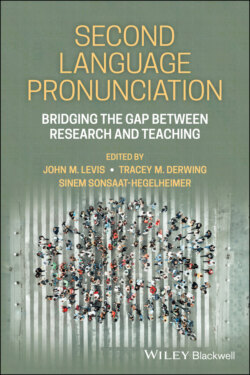Читать книгу Second Language Pronunciation - Группа авторов - Страница 32
Appendix: Doing a Basic Pronunciation Diagnostic
ОглавлениеOur vignettes assume that teachers perform some type of pronunciation diagnostic or needs analysis for their students. There are many ways to do such a diagnosis, depending on the teacher and students (for more, see Morley, 1991). For those unaccustomed to diagnosing pronunciation systematically, we offer a simple approach that can be used even with students who have limited English. The diagnostic process has three steps: recording, listening, and evaluating. It is not necessary to notice every detail. A general picture of important pronunciation needs emerges from the process of diagnosis.
1 Record each student’s speech for 30 seconds or more. Alternatively, have groups of students work together doing some type of speaking or pronunciation task. This can allow more efficient diagnosis. A voice recording is sufficient, but a video recording will enable evaluation of physical movements during speech. For more advanced learners, this might result in 2–3 minutes; for low-level learners, try for at least 30 seconds. Recording can come from an interview or a monolog such as “my favorite holiday celebration.” (We do not encourage the use of reading aloud for literacy-level learners. Navigating the spelling-sound interface will lead to many errors that do not show up in free speech.)
2 Listen to each recording, then name and evaluate the most prominent errors.
3 Evaluate the main errors that are true for each student and for the class overall. A possible rubric is provided below.
| Pronunciation Features | Holistic Scale | Errors Noticed (possible examples) | ||||
|---|---|---|---|---|---|---|
| Vowel sounds | 1 | 2 | 3 | 4 | 5 | “hit” sounds like heat “man” and “men” similar |
| Few errors | Many errors | |||||
| Consonant sounds | 1 | 2 | 3 | 4 | 5 | Initial consonants are mostly clear. Often deletes final consonants |
| Few errors | Many errors | |||||
| Voice Quality Settings | 1 | 2 | 3 | 4 | 5 | Minimal lip and jaw movement |
| Few errors | Many errors | |||||
| Thought groups | 1 | 2 | 3 | 4 | 5 | Phrases are usually very short or very long |
| Logical phrases | Phrases too short or long | |||||
| Word stress | 1 | 2 | 3 | 4 | 5 | Longer words have no clear stress |
| Correct stress | Unclear emphasis | |||||
| Intonation | 1 | 2 | 3 | 4 | 5 | Pitch sounds monotone. Not easy to know where sentences end. |
| Pitch rises & falls | Pitch flat or confusing | |||||
| Overall Fluency | 1 | 2 | 3 | 4 | 5 | A lot of silent pauses |
| Speaks smoothly | Speaks haltingly |
